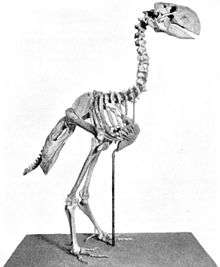Gastornithidae
| Gastornithids Temporal range: Paleocene - Eocene, 56–45 Ma | |
|---|---|
 | |
| Mounted skeleton (Gastornis giganteus) | |
| Scientific classification | |
| Kingdom: | Animalia |
| Phylum: | Chordata |
| Class: | Aves |
| Order: | Anseriformes |
| Family: | †Gastornithidae Fürbringer, 1888 |
| Type species | |
| †Gastornis parisiensis Hébert, 1855 | |
| Genera | |
|
†Gastornis | |
| Synonyms | |
|
Diatrymidae Shufeldt, 1913 | |
Gastornithidae is a family of prehistoric birds. The various species in this group lived from the Paleocene to the Eocene epochs and ranged from Asia and Europe to North America. All known species were very large, flightless ground birds, similar to ostriches but more heavily built and with huge beaks. Once thought to be carnivores, they are now considered to have been primarily herbivorous.[1][2]
Gastornithids are only known from a handful of species. The genus Gastornis itself contains three European species, as well as the North American species G. giganteus, a well-known prehistoric bird formerly classified as the distinct genus Diatryma. An Asian species, G. xichuanensis, was originally classified as the distinct genus Zhongyuanus. Apart from these, there are some indeterminate gastornithid species, including "Diatryma" cotei from the middle-late Eocene of France[3] Additional, fragmentary fossils that are difficult to classify in any particular genus or species include remains found in Paleocene rocks of Walbeck, Germany, and the specimen YPM PU 13258 from early Eocene rocks of Park County, Wyoming, possibly a juvenile G. giganteus[4]
Classification
Gastornis and its close relatives were long considered to be members of the order Gruiformes. However, the traditional concept of Gruiformes has since been shown to be an unnatural grouping. Beginning in the late 1980s and the first phylogenetic analysis of gastornithid relationships, consensus began to grow that they were close relatives of the lineage that includes waterfowl and screamers, the Anseriformes.[2] Recognizing the apparent close relationship between gastornithids and waterfowl, some researchers classify gastornithids within the anseriform group itself.[5] Others restrict the name Anseriformes only to the crown group formed by all modern species, and label the larger group including extinct relatives of anseriformes, like the gastornithids, with the name Anserimorphae.[6] Gastornithids are therefore sometimes placed in their own order, Gastornithiformes.[7]
A simplified version of the family tree found by Agnolin et al. in 2007 is reproduced below.
| Anseriformes |
| ||||||||||||||||||||||||||||||
| |
References
- ↑ Witmer, L. & Rose, K. (1991) Biomechanics of the jaw apparatus of the gigantic Eocene bird Diatryma; implications for diet and mode of life. Paleobiology 17(2):95-120.
- 1 2 Mustoe, G.E., Tucker, D.S., & Kemplin, K.L. (2012). "Giant Eocene bird footprints from northwest Washington, USA." Palaeontology, 55(6): 1293-1305.
- ↑ Mlíkovský, J. (2002) Birds of the World, Part 1: Europe. Ninox Press, Prague.
- ↑ Wetmore, A. (1933). Bird Remains from the Eocene of Wyoming. Condor, 35(3): 115-118.
- ↑ Agnolin, F. (2007). "Brontornis burmeisteri Moreno & Mercerat, un Anseriformes (Aves) gigante del Mioceno Medio de Patagonia, Argentina." Revista del Museo Argentino de Ciencias Naturales, n.s. 9, 15-25
- ↑ Andors, A.V. (1992). "Reappraisal of the Eocene ground bird Diatryma (Aves: Anserimorphae)." Science Series Natural History Museum of Los Angeles County, 36: 109-125.
- ↑ Buffetaut, E. (2002). "Giant ground birds at the Cretaceous-Tertiary boundary: Extinction or survival?" Special papers - Geological Society of America, 303-306.